Using rockwool for hydroponic growing
Welcome Here. I’ll share my tips and tricks on using Rockwool cubes in hydroponics. I’ve been doing this for a while now, and I think I’ve perfected the art. Keep reading to learn everything you need to know about Rockwool and hydroponics.
What is Rockwool?
Rockwool is a versatile manufactured material made from molten basalt rock spun into fibers. This process creates millions of tiny air pockets, making Rockwool an ideal growing medium for plants. The small pores in the Rockwool fibers help to aerate the root zone and hold onto moisture and nutrients, providing plants with everything they need to thrive.
Rock wool is a natural product that belongs to the family of mineral wool. It was discovered for the first time in Hawaii in the early years of the twentieth century. The results of the natural action of the active volcanoes of this archipelago. Later, the way to manufacture this material artificially from the basaltic volcanic rock was discovered.
The process involves melting the rock at a temperature of more than 1600 ° C to return it to its initial state of lava. The lava is poured into large wheels that rotate at very high revolutions, and through centrifugal force, this lava is transformed into fibers. An organic binder is added to gather the threads before compressing them lightly.

The composition of the rock wool is approximately 98% volcanic rock and 2% organic binder. One of its primary uses is thermal insulation and acoustic and passive protection against fire. Its fibrous and multidirectional structure allows it to accommodate a large amount of air. This is something that also makes it suitable for the hydroponics cultivation of all types of plants.
Is Rockwool safe to use? It is classified in the European Waste Catalog as Insulation material that does not contain asbestos or dangerous substances.
Rockwool is most commonly used in hydroponic systems but can also be used in soil and soilless mixes. It is available in a variety of different sizes and formats, including sheets, blocks, plugs, and slabs.

Benefits of Using Rockwool in Hydroponics
Now, let’s talk about why Rockwool is a fantastic choice for your hydroponic garden:
- Superior Water Retention: Rockwool holds water efficiently, reducing the need for frequent watering.
- Excellent Aeration: It provides the perfect balance of oxygen and water to plant roots, crucial for healthy growth.
- Stable and Sterile Medium: Free from pests, diseases, and weeds, Rockwool offers a clean start for your plants.
- Versatility: Whether you’re growing tomatoes or exotic herbs, Rockwool is suitable for a wide range of plants.
- Easy to Use: Perfect for beginners, it’s simple to handle and transplant in hydroponic systems.
- Sustainable Choice: Made from natural materials, it’s an eco-conscious option for your garden.
How does Rockwool help plants grow?
Rockwool is an ideal substrate for hydroponic systems because it is moisture and nutrient-rich and provides excellent drainage. The porous nature of Rockwool allows plants to take in oxygen and water quickly, which helps encourage strong root and plant growth. Additionally, Rockwool retains heat well, which can help create a warmer environment for plants during the colder months.
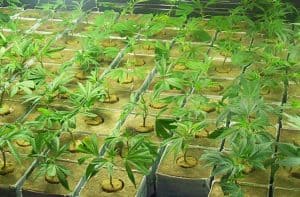
What size Rockwool cubes to use?
We shall talk about the small propagation cubes, which are perfect for germinating seeds and rooting cuttings. Rockwool comes in two sizes, 1 inch (25mm) and the ones that I prefer, which are 1.5 inches (35mm). The blocks are also perfect for continuing the cultivation in larger rock wool blocks or slabs and are 100% hydroponic.
When the time comes to transplant, we can opt for larger square blocks or slabs. The larger blocks usually come with a hole to introduce the sowing block into these come with a ready-made hole to take the 1 inch (25mm) or 1.5 inches (35mm), while when using the slabs, you can put the block on it. The roots will fix the plant in a few hours, so it is an operation that will take a few seconds.
Unlike pressed peat jiffy, rock wool never sheds waste, which is essential in automatic irrigation systems that can be easily blocked.
An added benefit is that It simply transplants into other mediums, clay pebbles, or coca blocks without affecting the behavior of any substrate.
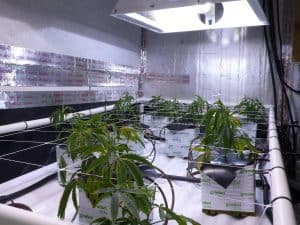
How to prepare Rockwool for hydroponics?
Rock wool can hold a large amount of water and oxygen. Rockwool blocks are cheap, and they can be used without pots or containers, as it is covered with a plastic or lining that will prevent the light from damaging the roots and their structure.
A vital step the first time we use rock wool plugs is to wash them to eliminate any possible residue. They also have a neutral pH of around 7, which is quite alkaline for growing cannabis. Once we have soaked them well, we can pass them to a bucket or tub with water with a pH of 4.5–5.5 and a low EC. After a slight draining, we are ready to use.
Before using, you must soak rock wool in a water and nutrient solution, which will help ensure that your plants have access to the nutrients they need to grow. You can soak rock wool in a bucket or tub of water for 24 hours before using it.
What to plant in Rockwool?
Seeds or clones do exceptionally well in Rockwool. For clones, make a hole in the block with a toothpick or something similar, introduce the stem, and press to eliminate excess water and, at the same time, ensure that the cutting is not loose and moving.
To plant in Rockwool, soak the block or cube in water until it’s saturated, then allow it to drain for an hour or so. This will help to prevent the roots of your plant from drying out. Once the block or cube has been soaked and drained, you can plant your seedlings or clones into it.
Starting seeds in Rockwool
For seeds, we can germinate them first in tissue and place them into the block as soon as they have a small root of approximately 3/8 inch (1 cm).
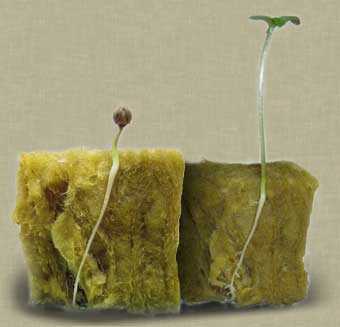
Or germinate directly in the block, after which it should be placed in a dark, warm place until the tiny seedlings appear.
Rock wool can quickly dehydrate, so this should be monitored carefully, especially during the first few days. The blocks can be held in a simple tray.
Rock wool is an inert substrate, so we must provide the necessary nutrients in each irrigation. You can use any quality line of nutrient solutions and follow the manufacturer’s recommendations regarding dosage and basic additives. In the growth phase, it is not advisable to exceed an EC of 0.60-0.70; in flowering, the EC should be around 1.40.
It is available in different grades, which are designed for different types of plants. For example, plants that require a lot of drainage, such as cacti, would do better in a lower grade with a lower density, while plants that require more water retention, such as cannabis, would do better in a higher grade with a higher density.
Be sure to keep an eye on the moisture level of your Rockwool, though, as it can dry out quickly. You may need to water your plants twice a day when using Rockwool.
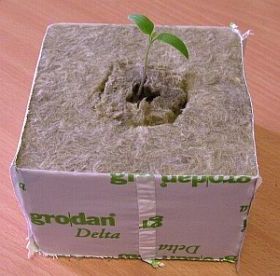
Caring for plants grown in Rockwool
Caring for your plants is relatively easy, and the steps are similar to how you would care for plants in other hydroponic systems.
Here are some general tips:
Make sure the roots have enough oxygen by regularly aerating the water.
Keep the pH level of the water between 5.5 and 6.5.
Flush the system with fresh water every two weeks to prevent the build-up of salts.
Check the temperature of the water and air around your plants. Optimal temperatures vary depending on the plant, but generally, you want to keep the water between 70 and 85 degrees Fahrenheit and the air around 65 to 75 degrees Fahrenheit.
Common problems with Rockwool and how to solve them
The most common problems with Rockwool are:
1. Algae and bacteria growth
2. Poor drainage
3. Incorrect pH levels
4. Compaction
5. Salinity build-up
6. Poor aeration
7. Rootbound
Let’s take a more detailed look at each of these problems and how to solve them:
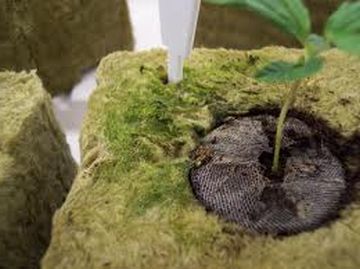
1. Algae and bacteria growth: Algae isn’t usually a problem as it only affects the top of the blocks where the light encourages growth, and it’s more unsightly than a problem. The leading cause of this bacterial growth is usually due to stagnant water, i.e., allowing the block to sit in dirty still water.
2. Poor drainage: If your Rockwool doesn’t drain properly, it can become waterlogged and start to rot. To avoid this, make sure the bottom of your container has suitable drainage holes, or if you use a Rockwool mix, you’re also using a well-draining growing medium such as perlite or vermiculite mix.
3. Incorrect pH levels: The ideal pH level for Rockwool is between 5.5 and 6.5. If the pH level is too low, it can cause nutrient deficiencies in your plants. If the pH level is too high, it can make it difficult for your plants to absorb nutrients from the Rockwool. You can test the pH level of your Rockwool with a simple soil test kit available from any garden center or online retailer.
Follow the instructions included with the kit to get an accurate reading. Once you know the pH level of your Rockwool, you can adjust it up or down as needed using phosphoric acid (for lowering pH) or hydrated lime (for raising pH).
4 . Compaction: Over time, Rockwool can become compact and dense, making it difficult for roots to penetrate.
5 . Salinity build-up: Another common problem with Rockwool is salt build-up from irrigation nutrients.
6 . Poor aeration: If roots don’t have enough oxygen, they will start to die off. This usually happens when growers use too much water without properly aerating their
7 . Roots becoming root bound if the plant you are growing becomes too large for the size of the Rockwool cube you are using, then just like any other potbound plant, it will lead to them not being able to access oxygen, water, and nutrients. If you see this happening, gently loosen up the affected area with your fingers and try to add more Rockwool or place it on a larger block.
Tips for using Rockwool cubes for growing in hydroponics
Hydroponic growing with Rockwool is an excellent way to grow, but there are a few things to keep in mind when using it. Here are some tips:
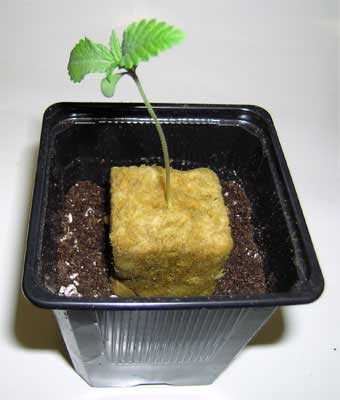
Before using Rockwool for hydroponics, be sure to soak the Rockwool in water for at least 15 minutes. This will help ensure that the Rockwool is saturated correctly and will help prevent plant roots from drying out.
-After soaking, you can add nutrients to the Rockwool before planting, providing nutrients for the plants as they grow.
Planting in Rockwool is a breeze, especially for novices. Here’s how to do it:
- Seeds:
- Place your seeds in the pre-soaked Rockwool cubes.
- Ensure the seeds are snug but not too deep – about twice the size of the seed itself.
- Clones:
- For clones, make a small hole in the Rockwool.
- Insert the stem gently, ensuring good contact with the Rockwool for moisture and nutrient uptake.
- Moisture Management:
- Keep the Rockwool consistently moist, but avoid overwatering to prevent root rot.
With your seeds or clones comfortably settled in Rockwool, they’re ready to grow into healthy plants!
When planting in Rockwool, be sure to plant the seeds or cuttings deep enough, so they are entirely covered by the Rockwool. This will help ensure that the roots have enough moisture and won’t dry out.
-It’s essential to keep the Rockwool moist but not too wet. Overwatering can lead to problems like root rot, so check the moisture level regularly and water only when necessary.
Caring for Plants in Rockwool
Taking care of plants in Rockwool is straightforward. Here are some key tips:
- Watering: Check the moisture level of your Rockwool regularly. It should be moist, but not waterlogged.
- Nutrients: As Rockwool is an inert medium, add a balanced nutrient solution tailored to your plant’s growth stage.
- Light and Temperature: Ensure your plants get adequate light and maintain a consistent temperature suitable for their growth.
- Monitoring pH: Keep the pH of the nutrient solution between 5.5 and 6.5 for optimal nutrient uptake.
- Pruning: Regularly prune your plants to promote healthy growth and prevent overcrowding.
By following these steps, you’ll nurture your plants for a successful harvest!
Frequently asked questions about Rockwool
Q:Why is Rockwool white?
A: The color of Rockwool indicates the quality. The brighter and whiter the shade, the higher the quality of the product. This is due to impurities being burned out during manufacture.
Q: Why is Rockwool dusty?
A: During manufacture, tiny pieces of Rockwool break-off, called ‘fines.’ However, don’t worry; these fines will not harm your plants as they are made from the same materials as the larger pieces of Rockwool.
Q: What is the difference between Horticultural Grade and Grow Rockwool?
A: Horticultural Grade Rockwool has a lower pH level and is less likely to cause problems with your plants’ roots. Depending on your needs, horticultural Grade Rockwool is also available in different coarseness. Grow Rockwool has a slightly higher pH level and is only available in one grade of coarseness.
Common Problems and Solutions
Even with the best care, you might encounter some issues while using Rockwool. Here’s how to tackle them:
- Algae Growth:
- Algae can form on wet surfaces exposed to light.
- Keep the top of the Rockwool cubes dry and limit light exposure to prevent algae.
- Incorrect pH Levels:
- Regularly check and adjust the pH of your nutrient solution.
- Aim for a pH level between 5.5 and 6.5 for most plants.
- Overwatering and Root Rot:
- Ensure adequate drainage and avoid letting Rockwool sit in stagnant water.
- Water only when the top inch feels dry.
- Salt Build-up:
- Flush your system with fresh water every few weeks to prevent salt accumulation from nutrients.
Addressing these common issues promptly will help maintain a healthy hydroponic system!
Conclusion
Growing marijuana in Rockwool is an efficient and effective method for hydroponic gardening. With the right preparation, conditions, and care, you can achieve a bountiful harvest. Remember to regularly monitor your plants and adjust your approach as needed. For more insights into hydroponic cultivation and cannabis care, explore our other articles, such as Growing Weed Indoors the Easy Way and Neem Oil for Pest Control in Cannabis Cultivation.

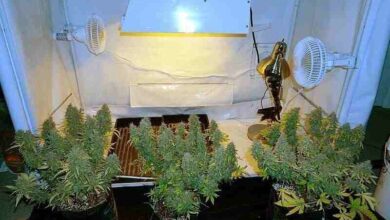

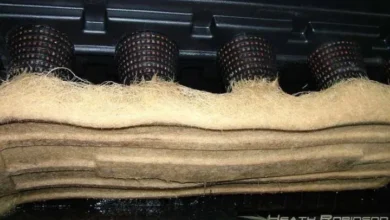
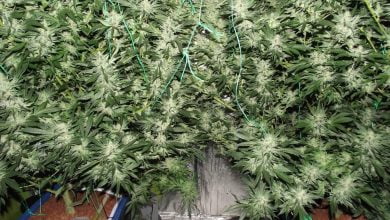
I’m wondering what dimensions you recommend for each stage, listed in cm?